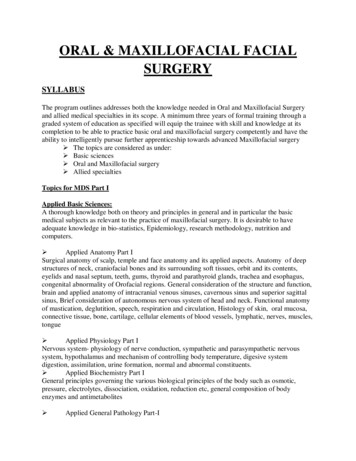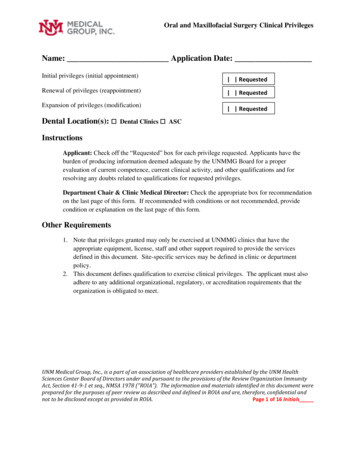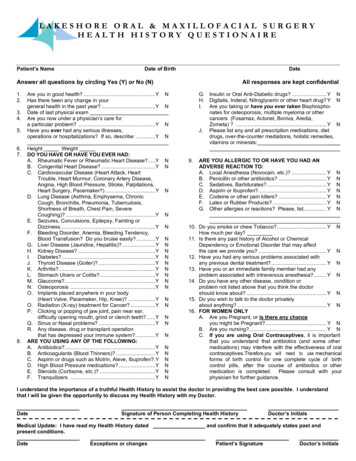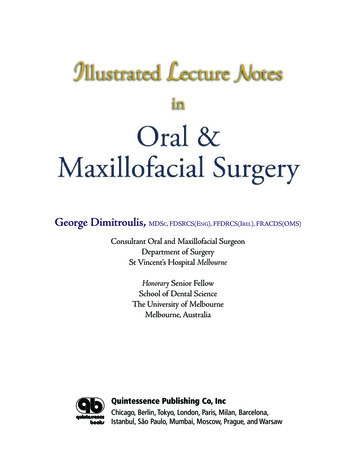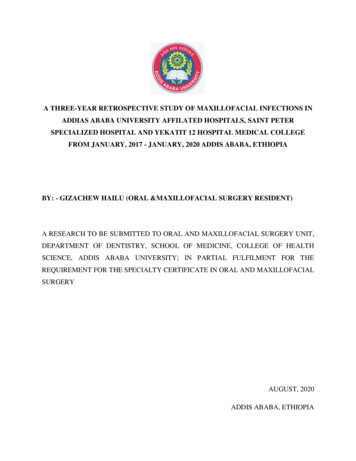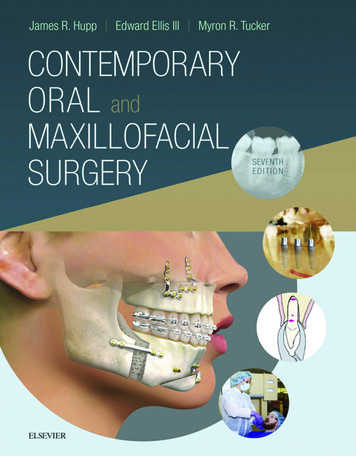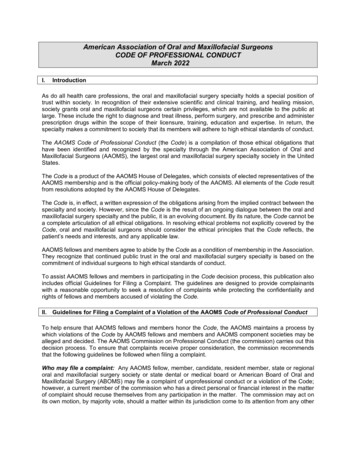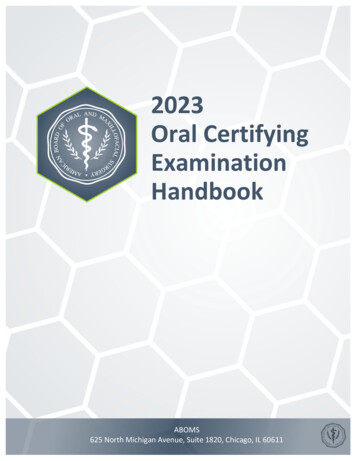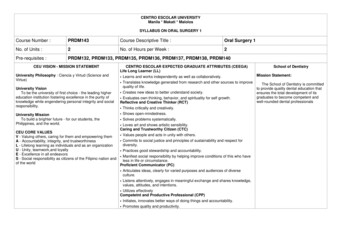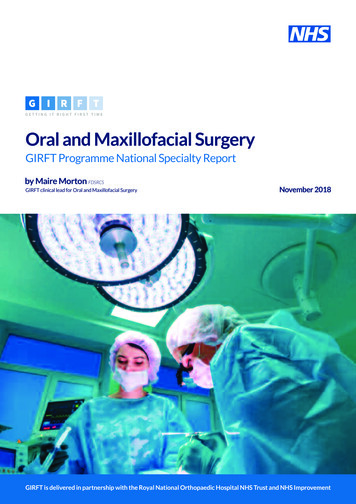
Transcription
Oral and Maxillofacial SurgeryGIRFT Programme National Specialty Reportby Maire Morton FDSRCSGIRFT clinical lead for Oral and Maxillofacial SurgeryNovember 2018GIRFT is delivered in partnership with the Royal National Orthopaedic Hospital NHS Trust and NHS Improvement
Foreword from Professor Tim Briggs GIRFT Programme ChairI am delighted to recommend this Getting It Right First Time review of oral and maxillofacial surgery by Maire Morton.Maire’s report brings the GIRFT approach to her own clinical specialty, combining a data-led view of outcomes and costs withreal insight into what is and is not working. I firmly believe that, with the support of clinicians and managers, it can lead to theredesign of services to improve care and patient outcomes – as well as saving the NHS millions of pounds.GIRFT and the other Carter programmes are already demonstrating that transforming provider services and investing to savecan bring huge gains in stabilising trusts financially and improving care for patients.The programme began following my review of orthopaedic surgery in 2012. That review was driven by a desire to ensure bettercare and outcomes for patients and to fix the issues faced by colleagues in my own specialty. With a small team, we visited over200 sites, meeting more than 2,000 surgeons, clinicians, support staff and trust managers. Almost everyone acknowledgedthat the NHS must review all unwarranted variation in the quality and efficiency of the services we deliver.Together we set out to understand the impact of that variation by reviewing data, discussing challenges and debating solutions.At the end of the process we were able to make evidence-based recommendations and to share the good practice we found.Today, with the support of my fellow clinicians and the British Orthopaedic Association, those recommendations are helpingto improve care and patient outcomes, as well as saving the NHS millions of pounds.That support is crucial. GIRFT cannot succeed without the backing of clinicians, managers and all of us involved in deliveringcare. So I am most heartened to hear how supportive people have been as Maire has been carrying out her review.My greatest hope is that GIRFT will provide further impetus for all those involved in the delivery of oral and maxillofacial surgeryto work together, shoulder to shoulder, to create solutions and improvements that have appeared out of reach for too long.GIRFT Programme Chair and NHS Improvement’sNational Director for Clinical Quality and EfficiencyProfessor Tim Briggs is Consultant Orthopaedic Surgeon at the RoyalNational Orthopaedic Hospital NHS Trust, where he is also Director ofStrategy and External Affairs. He led the first review of orthopaedic surgerythat became the pilot for the GIRFT programme, which he now Chairs.Professor Briggs is also National Director for Clinical Quality and Efficiency,at NHS Improvement.Professor Tim Briggs CBE2
ContentsIntroduction from Maire Morton.4Statement of Support: British Association of Oral and Maxillofacial Surgeons.5Recommendations .6Executive summary.9Oral and maxillofacial surgery today.12About our analysis.17Theme 1: Data quality and data collection .18Specialty coding.18Out-patient and day-case coding. 21Clinical coding .23Workforce and HR data.24Clinical outcome data . 25Theme 2: Performing dentoalveolar surgery in an appropriate setting.28Establishing the appropriate setting for dentoalveolar treatment .28General anaesthetic and comorbidity data.28Key influences on the current skew towards the secondary care setting.28Referral management and triage .29Theme 3: Improving efficiency by organising care through networks.32Developing hubs and spokes.32Ensuring equitable access to orthognathic treatment across England.36Reviewing the provision of maxillofacial laboratory services.38Theme 4: Optimising the secondary care pathway.40Follow-up to new out-patient attendances.40Non-elective workflow.43Readmission rates .47Theme 5: Litigation.51Theme 6: Procurement .55Product and technology procurement costs.55Activity opportunities and notional financial opportunities .58About the GIRFT programme .60Glossary .61Acknowledgements .64Appendix 1.653
Introduction from Maire MortonGIRFT National Clinical Lead for Oral and Maxillofacial SurgeryI was delighted to join the GIRFT programme to lead the oral and maxillofacial project.Our review has shone a light onto the specialty and allowed us to discuss the difficult issues that underlie variation in carepathways in oral and maxillofacial surgery, some of which add cost while adding no value to the individual patient.During my GIRFT visits, I have met many clinicians and managers. All were welcoming and interested in the data we presented.Indeed, for many it was the first time they had seen their own data. Data and its quality are key issues we explore further in thereport. All surgeons wish to deliver the best care for their patients, but without accurate and comprehensive data they cannotimprove their service.We have kept the British Association of Oral and Maxillofacial Surgery (BAOMS) fully informed of the work we’re doing at eachstage of our review. I am grateful to BAOMS for their totally supportive approach and delighted that their current president,Mr Ian Martin, has committed to and invested in a project to develop measurable clinical quality outcomes across the specialty.I am excited to put forward the recommendations in this report. I hope that the GIRFT project in oral and maxillofacial surgeryand the interest it has engendered in the specialty will further promote our ability to deliver the best outcomes for our patients.Maire Morton is a consultant oral and maxillofacial surgeon with special interests insurgery for facial deformity, maxillofacial trauma and medical leadership.Maire qualified from Guy’s Hospital, London and currently works at East LancashireHospitals NHS Trust, where she is also Divisional Director of Surgery and Anaesthetics.She was previously a member of the North West Cleft Lip and Palate Team, is a formerpresident of the British Association of Oral and Maxillofacial Surgeons (BAOMS), and ischair of the examination board for the Specialty Membership in Oral Surgery.Maire Morton FDSRCS4
Statement of SupportBritish Association of Oral and Maxillofacial SurgeonsBAOMS would like to thank Maire Morton and the GIRFT team for the enormous amount of work behind this report.We are pleased to see the importance the report has placed on the improvement of data quality and data collection. BAOMShas been working to have the specialty of OMFS correctly coded and we are encouraged by the prominence to coding andspecialty attribution given within the report.It is crucial that oral and maxillofacial surgeons have access to good quality and timely data to deliver high-quality, patientfocused services and we are pleased to see there is a series of recommendations to support this.Prospective data is at the core of the pilot project the Oral and Maxillofacial Surgeons Quality Outcomes in Oral andMaxillofacial Surgery (QOMS) (recommendation 5), which was my presidential initiative. We have already seen an excellentresponse from the specialty across all sub-specialty areas. By linking these audit projects to Hospital Episode Statistics(HES) and Office of National Statistics (ONS) we can reduce duplication of data entry and generate quality outcomeinformation to measure what matters.One of the most pleasing aspects of this report is that it has highlighted the volume of dentoalveolar surgery in secondarycare that may not always be appropriate. We are pleased that the report has outlined steps (recommendation 6) to helpensure this surgery takes place in the appropriate setting and BAOMS will work closely with NHS England and GIRFT tohelp achieve this.Furthermore, as outlined, the Managed Clinical Networks (MCNs) with OMFS representation are central to enabling anintegrated dentoalveolar surgery pathway which is best for patients.We will continue to work with GIRFT during the implementation phase, sharing examples of work taking place (includingthe devolved administrations) and the experiences from our members, to support the realisation of all 15 recommendationsoutlined in this report.Ian MartinBAOMS President5
RecommendationsWe have organised our recommendations into six themes.Details of owners and timelines for each recommendation are given in the body of the report.Theme 1: Data quality and data collection1Improve attribution to main specialty to ensure coded in accordance with the NHS Data Dictionary.1a Ensure that all work under the responsibility of consultant oral and maxillofacial surgeons is consistently attributedto their main oral and maxillofacial specialty in accordance with the NHS Data Dictionary.1b Where a consultant oral surgeon carries out oral surgery in an oral and maxillofacial unit, ensure that their work isattributed to their main oral surgery specialty in accordance with the NHS Data Dictionary.1c GIRFT to investigate options to measure or estimate the amount of activity performed by non-consultant careergrade staff under consultant supervision in all surgical specialties.2Improve clinical coding, particularly for difficult-to-code areas, such as head and neck cancer.2a Liaise with key stakeholders to develop a short guide to clinical coding for clinicians and coders that would supportbest practice.2b Offer specialty-specific coder training.2c Ensure that surgeons have easy access to their own data and are able to understand and interpret it.2d Ensure that surgeons, trust information teams and coders meet regularly to review activity attributed to thesurgeons.34Produce a clear definition of an out-patient procedure for data collection purposes.3a Agree the out-patient definition.3b Establish which oral and maxillofacial out-patient procedures meet the definition.Improve the recording of workforce and HR data to support workforce planning.4a Review and take actions to improve recording attribution of area of work in ESR.4b Investigate how national locum expenditure can be recorded by specialty.5Deliver an efficient and patient-focused outcomes audit programme for oral and maxillofacial surgery.5a Establish how to use real-time data, reduce the duplication of data collection supported by trusts and supportcontinuous improvement.5b Develop and evaluate a Quality Outcomes in OMFS (QOMS) pilot.5c Review the National Head and Neck Cancer Audit (HANA) with the other relevant specialties.Theme 2: Performing dentoalveolar surgery in an appropriate setting.6Take steps to ensure that dentoalveolar surgery takes place in the appropriate setting.6a Ensure correct coding of:the type of anaesthetic usedthe presence of an anaesthetistthe presence of any co-morbidities.6b Use the coding and comorbidities data to assess what proportion of dentoalveolar surgery could be carried out inthe different settings.6c Explore the potential impact of moving a proportion of dentoalveolar work out of secondary care and thefunctionality of the different settings available locally to support an integrated care pathway across both the electiveand non-elective elements. This is to include planning and contractual requirements.6d Based on the findings from 6b, 6c and examples of good practice, produce a plan to enable the development,implementation and continuous improvement of an integrated pathway for dentoalveolar surgery.6
Theme 3: Improving efficiency by organising care through networks7Deliver oral and maxillofacial surgery through local networks, such as hub and spoke models, to optimise qualityand efficiency.7a Develop guidance based on existing best practice examples to support the development of a service specificationfor local network reconfiguration. The guidance should cover the full oral and maxillofacial workload. We expectthe specification would be a minimum volume of approximately 300 non-elective admissions per year (representingaround one admission per day). It should also support contract, operational and geographical considerations.7b Support NHS England on the development and implementation of the revised head and neck cancer servicespecification.8Ensure equal access to orthognathic treatment across England.8a Review local access to orthognathic surgery.8b Review the outcomes of NHS England’s orthognathic commissioning guide and approval process pilot.8c Develop plan based on 8a and 8b.9Review how best to deliver maxillofacial laboratory services and technical services, taking changing needs, technologies,and practices into account.9a Undertake a separate dedicated review of maxillofacial laboratories and technological support. The report shouldinclude recommendations and actions.Theme 4: Optimising the secondary care pathway10 Explore how the number and types of non-surgical out-patient appointments can be reviewed.10a Understand if there are diagnostic codes that can be used to help record non-surgical out-patient appointments,and what the implications of introducing these may be.10b Introduce codes (depending on finding of 10a).11 Improve understanding of follow-up rates and take action accordingly to reduce unwarranted variation.11a Audit causes of current local follow-up rates.11b Ensure robust follow-up protocols are in place in all clinical areas to address unwarranted variation in local followup rates.11c Establish ongoing local audits to check that the new protocol is followed and action taken accordingly.12 Improve theatre utilisation and use of day case for emergency care in order to reduce length of stay for non-elective patients.12a Add national reporting of time to theatre for non-elective oral and maxillofacial patients once they are fit for surgeryto the theatre dashboard.12b Review variation in time to theatre and set a best practice target.12c Align with the development of the local networks (recommendation 7). Develop:specialty-specific emergency lists in larger unitsdedicated time in the general emergency theatre in smaller units.12d Explore the feasibility of including oral and maxillofacial trauma procedures in the British Association of Day Surgerydata directory.13 Improve understanding of readmission rates and take action accordingly to reduce unwarranted variation.13a Audit causes of current local readmission rates.13b Develop an action plan and ensure a robust standard protocol is in place.13c Establish ongoing local audits to check that the new protocol is followed and take action accordingly.7
Theme 5: Litigation14 Implement GIRFT 5 point plan for reducing litigation costs.14a Assess benchmarked position for estimated litigation cost per unit of activity compared to the national average.14b Review claims submitted to NHS Resolution to confirm correct coding. Inform NHS Resolution of any claims thatare not coded correctly at CNST.Helpline@resolution.nhs.uk14c Review claims in detail, including expert witness statements, panel firm reports, counsel advice and medical records,to determine where patient care or documentation could be improved.14d Triangulate claims with learning themes from complaints, inquests and serious untoward incidents (SUI). If a claimhas not already been reviewed as an SUI, we recommend that this is done to ensure no opportunity for learning ismissed.14e Where trusts are outside the top quartile of trusts for litigation costs per activity, GIRFT national clinical leads andregional hub directors will support them in learning from claims, including sharing examples of good practice.Theme 6: Procurement15 Enable improved procurement of devices and consumables through cost and pricing transparency, aggregation andconsolidation, and by sharing best practice.15a Use sources of procurement data, such as Purchase Price Index and Benchmarking tool (PPIB) and relevant clinicaldata, to identify optimum value for money procurement choices, considering both outcomes and cost/price.15b Identify opportunities for improved value for money, including the development of benchmarks and specifications.Locate sources of best practice and procurement excellence, identifying factors that lead to the most favourableprocurement outcomes.15c Use Category Towers to benchmark and evaluate products and seek to rationalise and aggregate demand withother trusts to secure lower prices and supply chain costs.8
Executive summaryOur GIRFT review of oral and maxillofacial surgery identifies significant opportunities to improve patient care and outcomesalongside a total notional financial opportunity of up to 25m per year.We have found a significant degree of unwarranted variation in a number of key areas. To help realise the opportunitiesavailable across the specialty, this report identifies where better quality of data is required to explore the variation further,examples of good practice and our recommendations.Getting It Right First Time (GIRFT)The GIRFT programme is funded by the Department of Health and Social Care and jointly overseen by NHS Improvementand the Royal National Orthopaedic Hospital NHS Trust.GIRFT seeks to identify variation within NHS care and then learn from that variation. It is one of several workstreamsdesigned to improve operational efficiency in NHS hospitals. In particular, it is part of the response to Lord Carter’s reviewof productivity, and is providing vital input to the Model Hospital project.GIRFT is closely aligned with other programmes seeking to improve standards while delivering efficiencies, such as NHSRightCare, acute care collaborations (ACCs) and sustainability and transformation partnerships (STPs)/integrated care systems.Under the GIRFT programme, data from many NHS sources is consolidated and analysed to provide a detailed nationalpicture of the specialty being reviewed. This process highlights variations in care decisions, patient outcomes, costs andother factors. The data is reviewed by a GIRFT clinical lead for the specialty – an experienced clinician who is recognised asan expert in their specialty.The clinical lead visits each individual hospital trust to discuss the data with senior management and clinical teams. These‘deep dive’ visits provide an opportunity for both parties to learn. The individual trusts are able to understand where theirperformance appears to be below average and can draw on clinical expertise to identify actions targeted at addressingperformance issues. At the same time, the clinical lead builds a national picture of best practice that feeds into service-wideimprovement recommendations and an implementation programme to drive change and address unwarranted variation.Oral and maxillofacial surgeryOral and maxillofacial surgeons treat the bony and soft tissue conditions of the head and neck, including the jaws, oral tissuesand teeth. The work ranges from relatively simple dentoalveolar surgery to long and complex surgery for head and neckcancer, facial deformity and pathologies of the face, mouth and jaws.Oral and maxillofacial trauma is a significant part of the workload.About our analysisWe have looked at variation in care pathways, some of which add cost while adding no value to the individual patient, suchas long waits to access emergency theatres.Clinical workstreamsOur review focuses on the following clinical workstreams:emergency care and traumahead and neck cancerfacial skin cancerdentoalveolar surgeryorthognathic surgery.Our review does not consider clinical services in the following areas:salivary gland diseasethyroid diseasetemporomandibular joint disease.9
What we foundWe found unwarranted variation in clinical practice and clinical outcomes between oral and maxillofacial units. Sixoverarching themes emerged.Theme 1: Data quality and data collectionOur review uses the quality outcome measures collected through Hospital Episode Statistics (HES), such as readmissions.However, we found a lack of consistency in coding, which makes analysis problematic.We found that oral and maxillofacial surgery does not have systematic clinical outcome measures in place. This limits opportunities:to understand if the specialty is being delivered in line with standards (such as those issued by NICE)for providers to benchmark themselves against othersto support continuous improvement.Models for measuring and collecting data on health outcomes are generally underdeveloped across Europe1. NICE offersguidance on best practice, but it is not always possible to measure the uptake of that best practice. An example of this issueis in sentinel node biopsy2 in early oral cancers. We set out to include data for this procedure in the data pack, but foundthat no episodes were identified, even though we know that some units offer the procedure. This suggests a lack of clarityaround coding this new procedure.As a result of our findings, a key focus of our report is on improving data quality and data collection to help ensure consistentcoding and the availability of accurate data to support service improvements, including workforce planning.We make recommendations on the urgent need to address coding issues. In response to our findings, BAOMS has alreadyinitiated the Oral and Maxillofacial Surgeon Quality Outcomes in Oral and Maxillofacial Surgery (QOMS) project.Theme 2: Performing dentoalveolar surgery in an appropriate settingMany oral and maxillofacial units are carrying out high volumes of dentoalveolar surgery. We believe the volumes are sohigh that resources are not being used optimally and that a significant proportion of dentoalveolar surgery could be carriedout in a more appropriate setting.A number of complex issues3 are pushing patients towards secondary care. These include patients not accessing primarycare dentistry frequently enough (possibly due to cost4 and anxiety5), leading to patients being referred directly to secondarycare by their GP.Depending on the level of treatment complexity6, the type of anaesthetic required and whether there are any comorbidities,a higher proportion of dentoalveolar surgery could be done as a level 2 (intermediate care) procedure. However, during ourdeep dive visits, a number of units expressed the opinion that the current provision of level 2 intermediate services couldbe improved. A number of issues were raised, predominately around staffing and service set up.We have been unable to explore the appropriateness of setting fully as codes for type of anaesthesia are generally not usedand comorbidity codes are not used consistently.Theme 3: Improving efficiency by organising care through networksOral and maxillofacial is a relatively small specialty. As the nature of the surgery has developed and junior training hasevolved, most units have come together to work across trusts.1Enhancing value in European health systems: The role of outcomes measurement, Consensus nt.pdfNICE Quality statement 3 (developmental) Sentinel lymph node h-node-biopsy23An evaluation of a referral management and triage system for oral surgery referrals from primary care dentists: a mixed-methods study, Goldthorpe, Walsh, Tickle, Birch, Hill,Sanders, Coulthard, and Pretty, Health Services and Delivery Research Vol. 6 (8), Feb 20184Cost and anxiety are barriers to dental care. In 26% of patients, treatment is affected by cost. 12% of patients had MDAS scores of 19 or more, indicating extreme dentalanxiety, while 36% had scores of 10 to 18, indicating moderate dental anxiety. Theme 8: Access and barriers to care – a report from the Adult Dental Health Survey 2009.7% of the population never attend a dentist and 12% only when in pain. Public perceptions of choice in UK dental care: findings from a national survey. BDA, October2012.510Guide for commissioning oral surgery and oral medicine, NHS England, 6
One of the big drivers for change was the need to centralise head and neck cancer services. This move started with theCalman-Hine report in 19957, was subsequently reinforced by the NHS cancer plan in 20008 and then again by the NICEhead and neck improving outcomes guidance (IOG) in 20049. A report in 2014 showed a reduction in the number of unitsoffering head and neck cancer services10.Some of the bigger units now sit at the centre of fairly extensive hub and spoke systems (local networks). I believe thatcontinuing this process, while ensuring there is effective embedded governance, is the way forward for our specialty.We found regional variation in volumes of orthognathic treatment across England that suggests a picture of inequitableaccess to treatment. We recommend that local access to orthognathic surgery is further explored. The development of localnetworks may help to improve access where units currently carry out only a small volume of orthognathic surgery.Theme 4: Optimising the secondary care pathwayThere are opportunities to release capacity and optimise the secondary care pathway by reducing unwarranted variationthrough agreed best practice in follow-up to new outpatient attendances, non-elective workflow and readmission rates.There is a wide variation in the follow-up to new ratio between providers that is not wholly a result of casemix. As unitsundertaking more complex surgery don’t necessarily have higher follow-up to new ratios, the variation must be influencedby process and decision-making factors.Generally oral and maxillofacial non-elective work should not require a long pre-operative stay: cases either need to go totheatre quickly or can be added to a planned list. However the data and deep dive feedback highlighted variation in lengthsof stay and the management of non-elective cases. We have recommended the need to improve theatre utilisation and useof day case for emergency care in order to reduce length of stay for non-elective patients.We found high levels of variation in readmission rates. When we explored this with units, they were generally unaware thattheir rates were high and were unable to explain why this was the case. It is essential that each unit understands itsreadmission rates and takes action to reduce any unwarranted variation.Theme 5: LitigationWe found wide variation in the levels of litigation experienced by different trusts.There has been an
7 Deliver oral and maxillofacial surgery through local networks, such as hub and spoke models, to optimise quality and efficiency. 7a Develop guidance based on existing best practice examples to support the development of a service specification for local network reconfiguration. The guidance should cover the full oral and maxillofacial workload.
